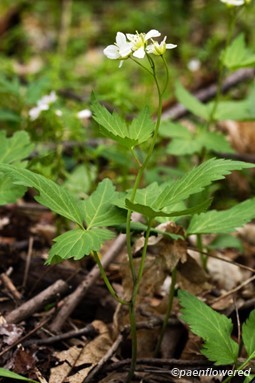Cardamine maxima
Cardamine maxima large toothwort
This species differs from the cut-leaved toothwort in having 3 leaves branching off the stem at different levels in alternating fashion rather than at the same level. The leaves also may be larger and less deeply cut, but I have seen literature that shows the leaves also resembling those of the cut-leaved toothwart.
The flowers are white, pink or pale purple. Like other toothworts the flowers have four petals. It grows 6-16 inches tall and is found in moist woods and along stream banks in northeastern United States and southeastern Canada. The blooming period is April through June, depending on location.
Although it is genetically distinct from the other species of toothwort some botanists in Michigan think it might be of hybrid origin because the fruit may not mature and the seeds may not be fertile. If it is a hybrid it is between C. concatenata and C. diphylla. It is also called the three-leaved toothwort. The USDA shows it in only four counties in Pennsylvania, but it is certainly more widespread since their data is based largely on herbarium specimens.
Habitat & Range
Grows in low, wet woods and is rare.
Scattered throughout the state.
Wetland code: Not classified
Phenology
Flowers April through May.
Plant Codes
PA status: PT (PA Threatened)
S-rank: S2 (Imperiled)
G-rank: G5 (Secure)











